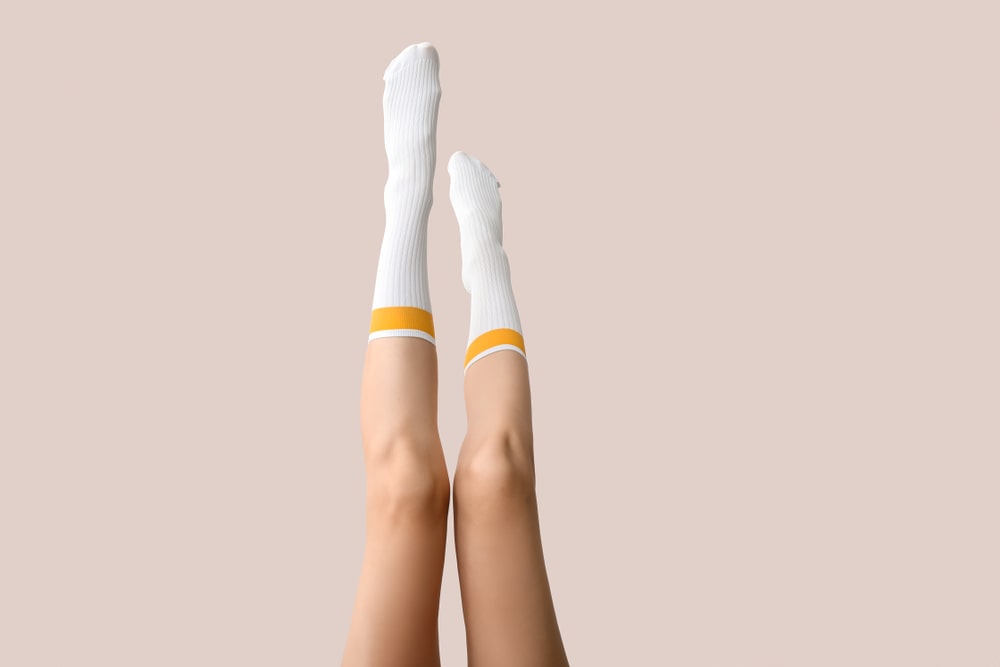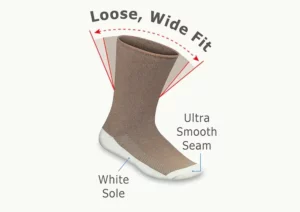How Can Nano Socks Help with Diabetic Neuropathy?
Nano socks seem to be gaining much ground on the socks market lately, especially for peripheral neuropathy and diabetic foot problems.
So, what’s the deal exactly? What are nano socks, and are they better than regular socks? Do nano socks help with neuropathy and diabetes foot problems? What else are they good for?

What are Nano Socks?
When you quickly search the Internet about nano socks, things are unclear. No one can tell what nano socks are. Some say they’re light compression socks, while others refer to a top-notch secret technology.
It’s much simpler than it looks. Nano socks are socks made from nano textile.
Socks made with nano fabrics
The adjective “nano” refers exclusively to the socks’ fabric: no unique technology, no compression stories. You can find non-binding, nano socks that provide light compression and other athletic compression socks.
Nanofabrics are textiles engineered with smaller particles than ordinary materials. You can make nano fabrics directly from nanoscopic fibers or by coating a regular fabric with silver or copper nanoparticle solutions.
Nano Socks’ Benefits
Nanotechnology applied to the textile industry has numerous and various benefits. Futuristic clothing made with nano fabrics is antimicrobial, water-resistant, self-cleaning, and odor-reducing.
Nano socks have exciting properties to help improve overall foot health, including:
- Stretchability to help boost blood circulation
- Anti-bacterial and anti-fungus
- High moisture-wicking capacity to keep feet dry
Do Nano Socks Work for Neuropathy?
The properties of nano textiles make nano socks attractive for people with various foot problems, especially those with diabetic neuropathy.
While nano socks can help with neuropathy in the feet, the fabric isn’t the only thing that matters when choosing socks for neuropathy.
What is neuropathy?
There are various types of neuropathy, but we’re referring here exclusively to peripheral neuropathy. Peripheral neuropathy is a kind of damage to the nerves of the body’s extremities. It’s most often caused by diabetes (diabetic peripheral neuropathy) but may also be caused by chemotherapy treatments for cancer, alcoholism, exposure to toxins, injuries, or other factors.
Symptoms of peripheral nerve damage vary considerably depending on the individual. They may include numbness, loss of sensation, tingling, prickling, burning, cramps, sensitivity to touch, and others.
Peripheral neuropathy primarily affects the feet and sometimes the hands. Feet with neuropathy are very fragile and prone to numerous complications. Adapted footwear such as neuropathy socks or neuropathy shoes is often recommended.
Why are nano fabrics suitable for foot neuropathy?
Fabric is essential when it comes to socks; good-quality materials can make a difference.
Nanotechnology textiles have numerous properties that benefit people with diabetes and neuropathy foot problems. They’re water-resistant, moisture-wicking, and anti-bacterial.
When you live with diabetes, and even more so if you have neuropathy, you must keep your feet in a dry and healthy environment to avoid moisture and bacteria. Tiny infections, fungus, blisters, and minor wounds can become nightmares for people with diabetes with neuropathy, including foot ulcers and lower-limb amputation in the worst cases.
Nano socks also have better elasticity and strength than regular socks. It helps boost blood circulation in the lower limbs. People with diabetic neuropathy often suffer from poorer blood circulation and need non-constrictive and loose-fit footwear that helps promote blood flow.
The exceptional properties of nano textiles are valuable to diabetic socks’ design.
The Best Nano Socks for Peripheral Neuropathy
Here’s a selection of the best nano socks for neuropathy and diabetes foot problems. So that you know, some of the socks below are compression socks. If you have neuropathy, always ask for your doctor’s advice before wearing compression socks.
1. Orthofeet bamboo & graphene nanomaterial socks for neuropathy
- 50% bamboo fibers + graphene nanomaterial
- Designed for diabetes, edema, neuropathy, sensitive feet, and poor circulation
- Non-constricting and lose knit
- Highly stretchable
- Seamfree sock interior to prevent blisters and sin abrasion
- Extremely soft and comfortable
- Machine washable
- 30-day free wear test
2. MediPeds nanoglide technology non-binding socks
- Integrated nano glide technology
- Designed for diabetes, swollen feet, neuropathy, and poor circulation
- Non-binding top and pull-on closure
- Seamless toe and blister-proof interior
- Soft cushioning for extra comfort
- Great shock absorption in high-impact areas of the foot
- Machine washable
- Made in the USA
3. OrthoSleeve nano bamboo charcoal wellness socks
- Nano bamboo charcoal fibers
- Designed for feet with diabetic neuropathy
- Non-binding top
- Light gradient compression
- Seamless construction
- Extra padding
- Midfoot arch support & Y-Gore heel
4. Langov nano compression foot sleeves for neuropathy
- Foot sleeve (open-toe socks)
- Graduated compression (ask for your doctor’s advice)
- Great foot stability
- Made to help relieve diabetic foot pain
- Machine washable
Nano Socks Vs. Compression Socks?
Most nano socks on the market are compression socks and apart from the ones above, you won’t find many nano socks designed for diabetes and neuropathy.
People with diabetes are generally not recommended to wear compression socks, except in some cases, but you’d want your doctor’s advice.
Compression socks are made to promote blood flow from the legs back to the heart. On the contrary, diabetic socks should help boost blood flow from the heart to the lower limbs. That’s why diabetic socks are non-binding! To let blood flow towards your feet.
If you suffer from nerve pain in the feet and other neuropathy symptoms, compression socks may sometimes help alleviate the pain. However, be aware that compression socks may also be dangerous if you have peripheral neuropathy. Always ask for your doctor’s advice before wearing compression socks, especially if you have diabetic neuropathy.
Nano socks Vs. Bamboo socks?
Bamboo is another great fabric that is particularly recommended for diabetics’ socks. Like nano socks, bamboo socks are moisture-wicking, anti-bacterial, odor-controlling, and abrasion-reducing.
Bamboo fibers also have the advantage of being thermo-regulating, keeping your feet warm in winter times and cool in summer times.
Related article:
